12 Tracking the Source of Viral Photos
Another type of content that often goes “viral” is photography. It is also some of the most difficult to track to a source. Note the example (below).

So, what is the story here? To get more information, insert the textual information off the image and do a Google search:
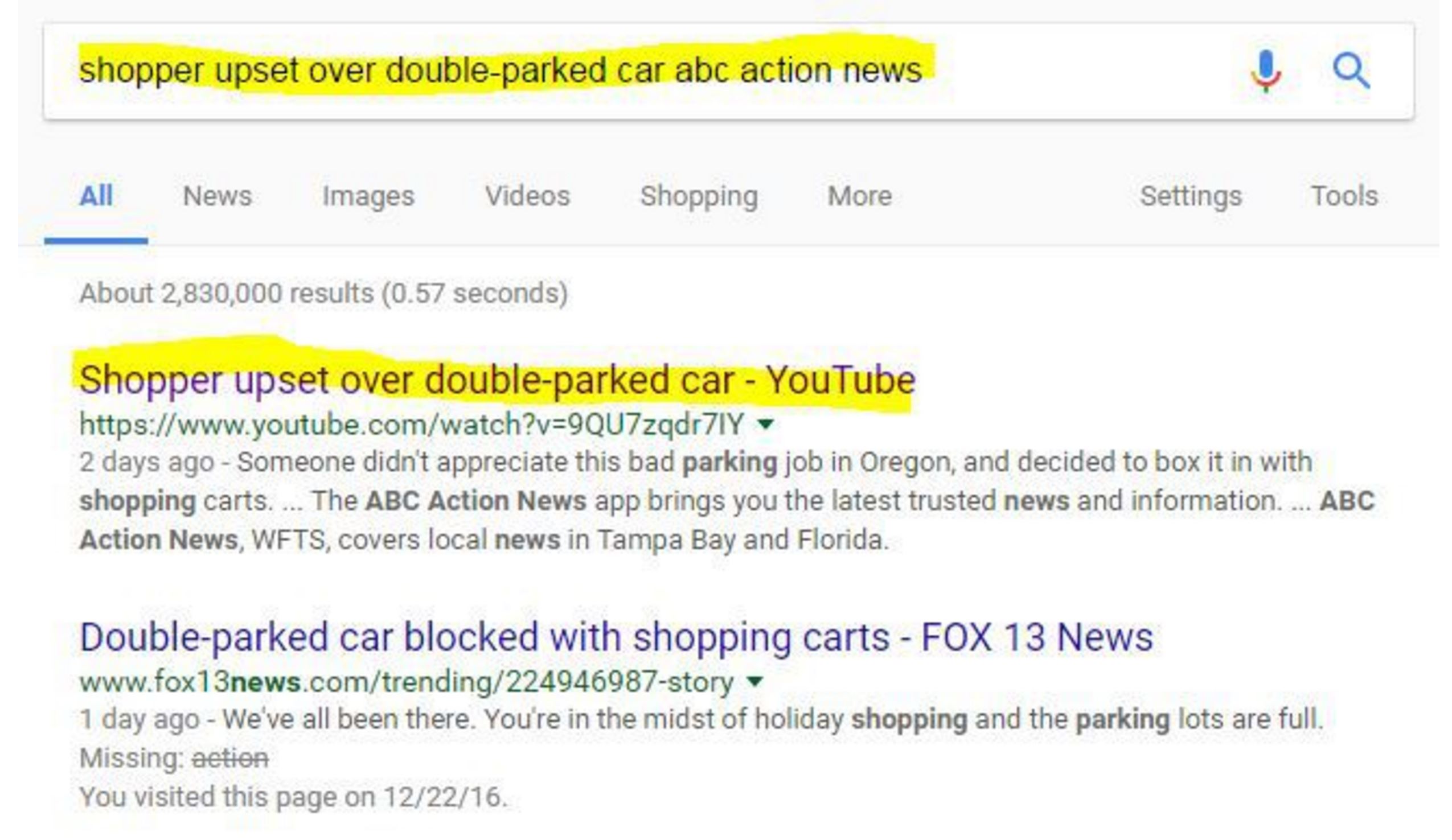
A YouTube video indicates that this was taken “outside a Portland, Oregon Walmart” and has been shared “hundreds of times since yesterday.” We will continue to trace the source with this new information. The next result shows why it is important to continue the search beyond the first set of results.
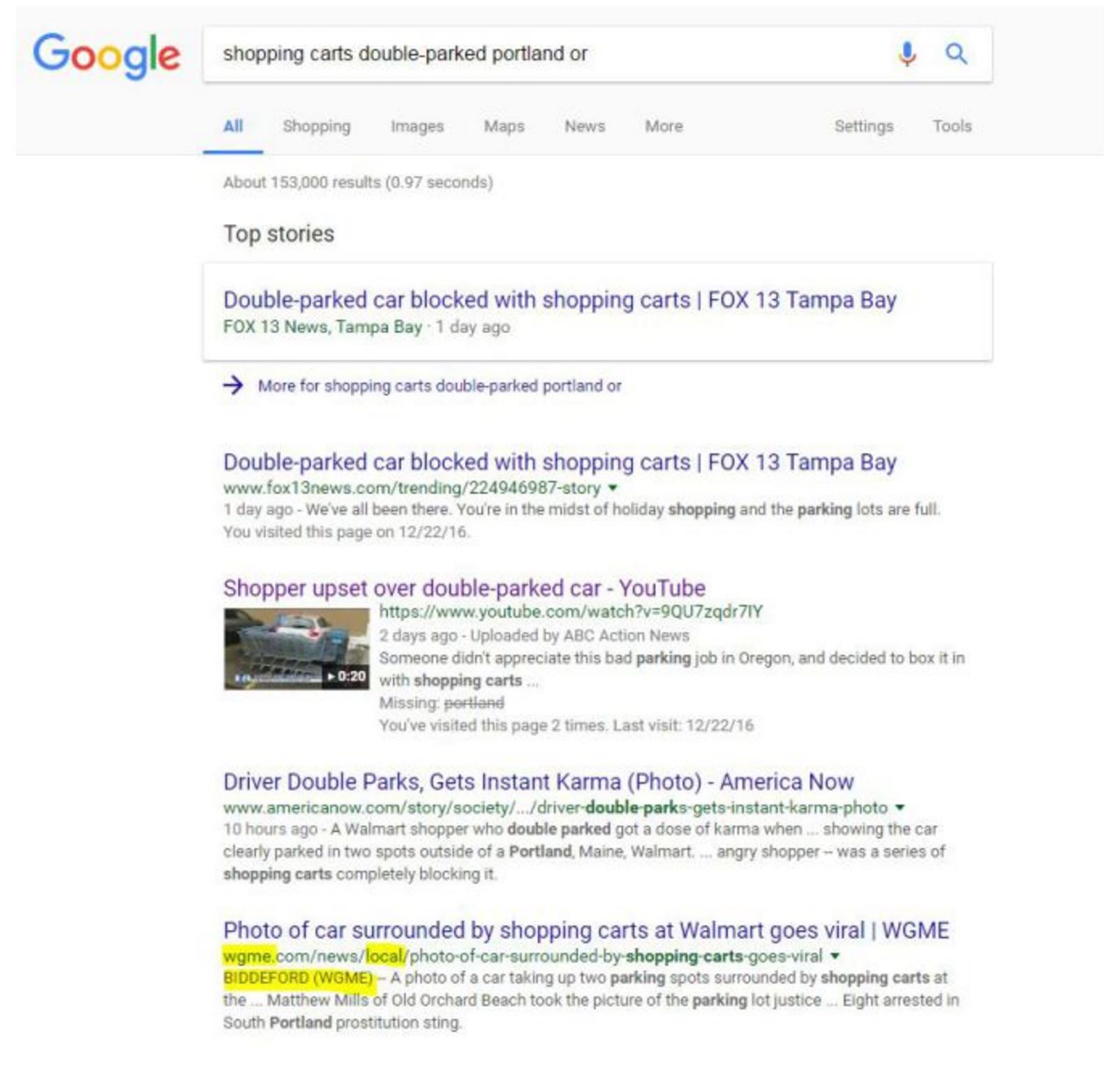
Which one of these items should I click on? Again, the idea here is to get closer to the actual event. One way to do that is to find the earliest post, but another way is to get geographically closer to the source. Who is more likely to get the facts of a local story correct, the local newspaper or a random blog?
As you scan the search results, look at the URLs. Fox 13 News has it in “trending.” AmericaNow has it in the “society” section. But the WGME link has the story in a “news/local/” directory. This is interesting, because the other site said it happened in Oregon, and here the location is clearly Maine. This URL pattern is a strong point in the website’s favor.
Further indications that it might be a good source is that in the blurb it mentions the name of the photographer, “Matthew Mills.” The URL plus the specificity of the information tell us that we are on the right track.
This takes us to what looks like the news page where it went viral, which embeds the original post.

We see that the first news report contained many inaccuracies. The photograph was not taken in Portland, Oregon—it was in Biddeford, which is near Portland, Maine. It has not been shared “hundreds of times” – it has been shared hundreds of thousands of times. And it was made viral by a CBS affiliate, a fact that ABC Action News in Tampa does not mention at all.
Now let’s look at the Facebook page where Matthew Mills shared it. We are looking to determine whether or not this went viral before CBS picked it up. We will double check that Mills is really from the Biddeford area and whether he was responsible for the shopping carts or just happened upon the scene.
The news post does not link back to the original, so we search for Matthew Mills again. We find some news outlets mentioning the original caption by Mills – “This guy got a lesson in parking.”
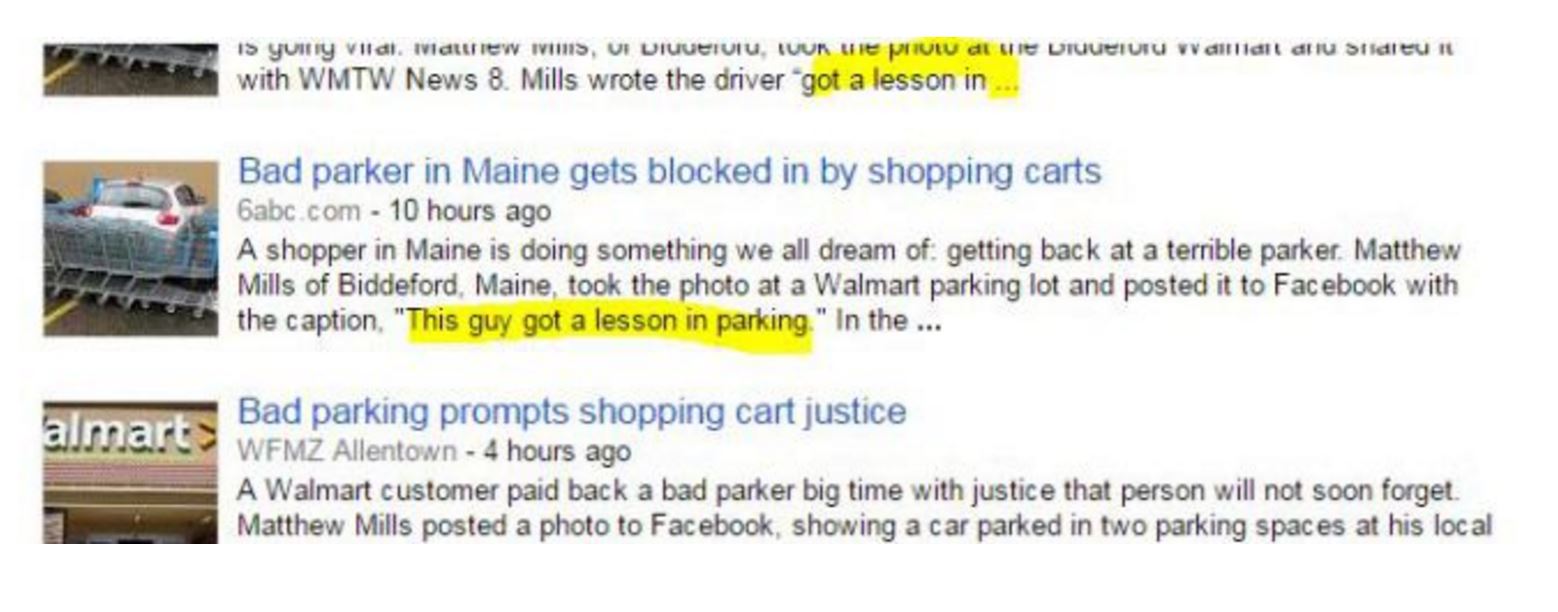
That is not the same as the caption that the news station put up – maybe it is what Mills originally used. We type “‘got a lesson in parking’ Matthew Mills” into Facebook, and we arrive at the original post.
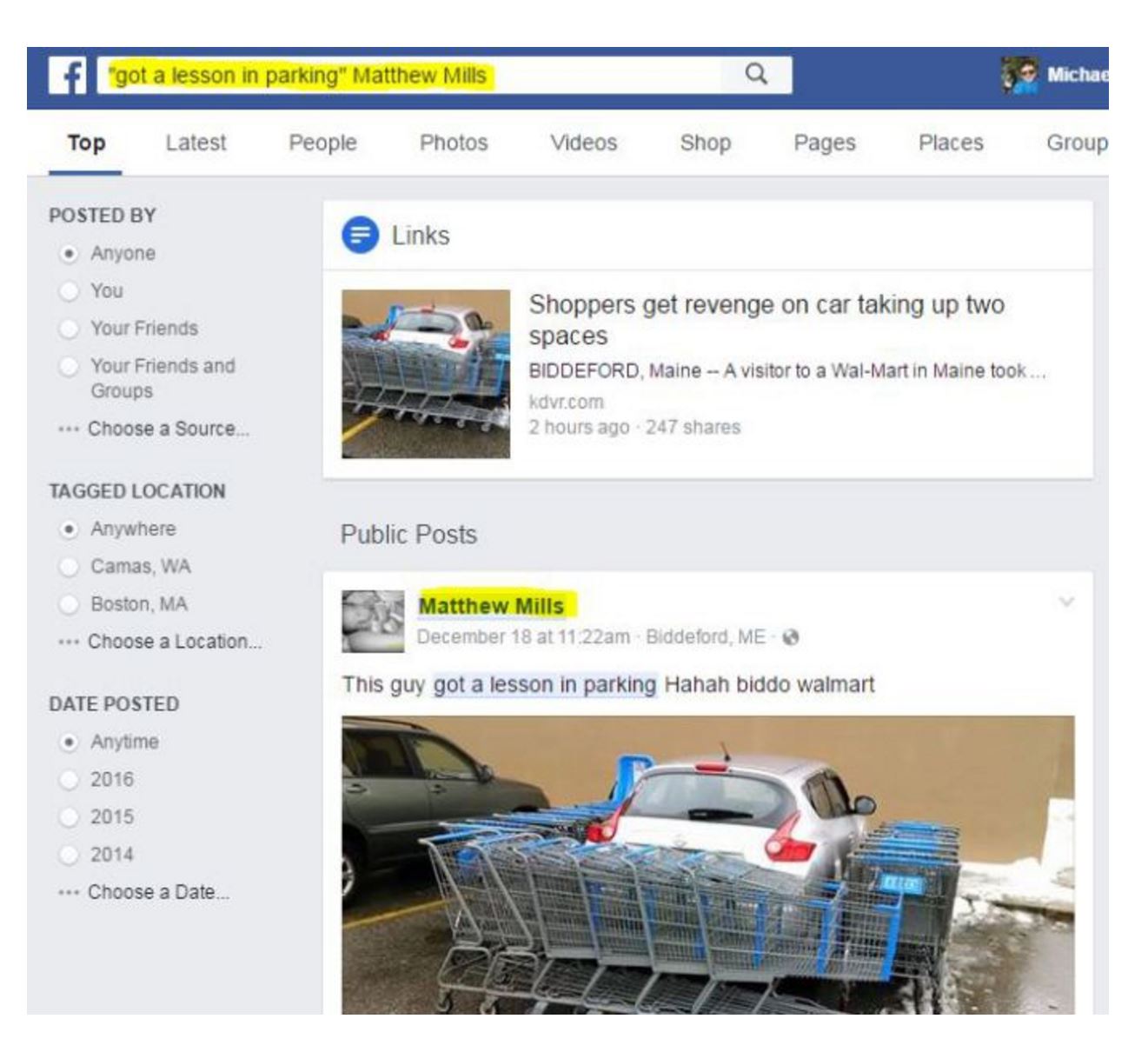
Now we see an unfortunate practice perpetrated by some news organizations. They will cut other news organizations out of a story. In this example, ABC Action News said that the photograph had been shared hundreds of times, when in fact it was shared hundreds of thousands of times. If they had been completely truthful, ABC Action News would have mentioned that is was actually popularized by a CBS affiliate.
This practice can make it easier to trace something to the source. News organizations work hard to find the original source if it means they can cut other news organizations out of the picture. But it also tends to distort how virality happens. The picture here did not magically become viral—it became viral largely due to the reach of WGME.
Incidentally, we also find answers to other questions in the Matthew Mills version – he took the picture but didn’t arrange the carts, and he really is from Old Orchard Beach.
An extra verification step is to use Google Images to determine whether the photograph is a recycled image. Sometimes people take old images and pretend the images are their own – changing only the date and location. A Google reverse image search (see below) indicates that this does not appear to be the case in this instance; however, this is a very common type of viral photo called a “parking revenge” photo. The specific technique of circling carts around a double-parked car dates back to at least 2012.
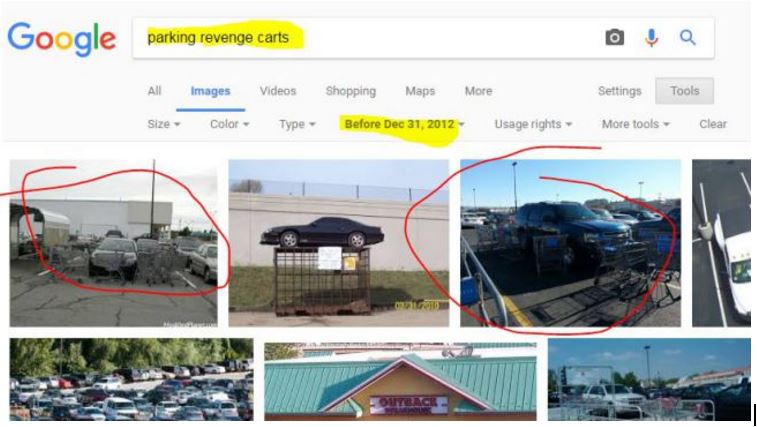
When we click through we can see that the practice was popularized, at least to some extent, by Reddit users. Note the post from December 2012:
![End. FIGURE 28 A tweet by user @NinjaEconomics that reads “On January 3, the #GDPNow model forecast for real GDP growth in Q4 2016 is 2.9%” and shows a chart about the GDP forecast. End. FIGURE 29 A tweet by @unsmokable that reads “the life of a national geographic photographer” and shows a photo of a man standing on volcanic terrain and looking through a camera situated on a tripod. The photographer’s shoes and tripod have flames around them. End. FIGURE 30 A closer crop of the tweet by user @unsmokable showing the results when a viewer right-clicks/control-clicks on the image. End. FIGURE 31 Results from a Google reverse image search on the photo from Twitter user @unsmokable’s tweet. End. FIGURE 32 A Reddit post titled, “In the heat of the moment” with comments debating over the photo of the photographer with flaming shoes and a tripod. End. FIGURE 33 An article by Katie Hosmer titled “Hot Lava Sets Adventurous Photographer’s Feet on Fire.” End. FIGURE 34 A close up of the article by Katie Hosmer showing the text “via [PetaPixel].” End. FIGURE 35 Text from the PetaPixel site quoting the photographer of the lava photo, reading, “The photo is real, but the flames are not the result of spontaneous combustion” going on to explain that the photographer used an accelerant to start the flames. End. FIGURE 36 Close up of the PetaPixel site showing the results when a reader right-clicks/control-clicks on the Hawaii News Now link. End. FIGURE 37 The Google results from searching “Hawaii News Now.” End. FIGURE 38 A photo Twitter users attributed to National Geographic, which depicts what appears to be a photographer being attacked by a bird. End. FIGURE 39 A Google reverse image search result that suggests the best search term to find our original source is “birds attacking people.” End. FIGURE 40 A list of pages including images that match the reverse searched image. The first webpage is titled, “Dangerous Birds – Top 10 Birds That Could Kick Your Ass.” All of the pages appear to discuss bird attacks. End. FIGURE 41 An expanded settings list for Google reverse image search that can be accessed by clicking “Tools” and “Custom range…” These settings can be altered to filter out newer photos by modifying the dates that will be included in the results list. End. FIGURE 42 A new reverse image search, with a custom date of Dec 31, 2009 to exclude newer photos, such as those which may have been virally propagated under false pretenses. Now, our suggested search term is “bird.” End. FIGURE 43 The result page of our reverse image search, in which the title of the third website, PentaxForums, reads, “Got too close the the hawk :(,“ and the description reads: “And as the poster said, these are trained…so its more like the camera man pissed off the hunter rather than the bird itself. Rest of the photos. Kazakhstan Eagle…” End. FIGURE 44 An article from the Press titled, “Kazakhstan Eagle Hunt,” which features our image. End. FIGURE 45 A list of Google search results of the search term, “stockton ca local affiliate.” We will select the fourth listing, CBS Sacramento. End. FIGURE 46 CBS Sacramento search with “teenage girls black lives matter” in the search bar. End. FIGURE 47 A photograph depicting a group of photographers running from a bear. End. FIGURE 48 A photograph in which a man in a body of water is hiding with a camera in a swan hunting tent. End. FIGURE 49 A photograph showing a section of a city empty and in shambles with what appears to be debris cluttering the buildings and streets. End. FIGURE 50 A photograph depicting a large stone ram on top of a semi-truck with the “OVER-SIZE” label on its front bumper. The ram appears to be more than three times the height of the semi-truck. End. FIGURE 51 A screenshot of the Baltimore Gazette, a site created to spread misinformation. The headline reads, “Clinton Received Debate Questions Week Before Debate, According to Sources.” End. FIGURE 52 A Google search tip demonstrating how to exclude a specific site from search results. The string used in the example is “baltimoregazette.com -site:baltimoregazette.com”. This would search all sites except for “baltimoregazette.com.” End. FIGURE 53 The homepage of the Pacific Justice Institute. End. FIGURE 54 Google search results for “www.pacificjustice.org -site:www.pacificjustice.org.” The search omits the site www.pacificjustice.org and brings up a Wikipedia article as the first result. End. FIGURE 55 WHOIS search result on the ICANN interface for “motherjones.com.” It displays the website’s owner, Foundation for National Progress, and its contact information. End. FIGURE 56 WHOIS search result on the ICANN interface for “baltimoregazette.com”. The website’s owner is listed as Domains by Proxy. End. FIGURE 57 A close up of baltimoregazette.com’s date of creation from WHOIS on the ICANN interface, which is listed as July of 2015. End. FIGURE 58 An article published in the peer-reviewed journal PLOS Medicine. End. FIGURE 59 A Google search for “plos medicine impact factor,” which indicates in the knowledge panel its impact factor is 13.585 as of 2015. End. FIGURE 60 An article published in the Journal of Obesity and Weight-loss Medication whose impact factor we want to investigate. End. FIGURE 61 A Google search for “Journal of Obesity and Weight-loss Medication impact factor” whose impact factor does not appear in a knowledge panel. End. FIGURE 62 The Google Scholar search results for “David Bann,” which features his many publications in lifespan obesity patterns. Most of the publications we find are from the last ten years. End. FIGURE 63 The AnonHQ article titled, “It’s Official: European Scientific Journal Concludes 9/11 was a Controlled Demolition.” The article has over 14,000 views and was published on September 11, 2016. End. FIGURE 64 The Google Scholar search results for “Robert Korol,” who appears to have published architectural research in the 1970s, 80s, and 90s. End. FIGURE 65 The Google Scholar search results for “Jennie Connor 2016,” which shows her well-cited publications. Her 2017 article received 12 citations, and two articles were cited by 23 and 36 others. End. FIGURE 66 The Google search results for “addiction impact factor,” which we find in the knowledge panel to be 4.145 as of 2010. End. FIGURE 67 The Google search result for “nih alcohol and cancer.” The fifth result from the NIH is described as “A fact sheet that summarizes the evidence linking alcohol consumption to the risk of various cancers…” End. FIGURE 68 The Google search result for “www.cancer.gov -site:www.cancer.gov.” This search includes all sites other than www.cancer.gov. We see that five results down, the National Health Institute, an organization we trust, is talking about the National Cancer Institute. End. FIGURE 69 A tweet by Twitter user @MichaelESmith that reads, “Bullshit! Aztec society collapsed in 1519 fr. Cortes & smallpox. Salmonella in 1540 was far too late. And the painting is European fantasy.” Smith is responding to a tweet claiming that salmonella poisoning may have contributed to the fall of the Aztec civilization. End. FIGURE 70 A tweet by @pixelatedboat featuring a photo of two men that reads, “This is Woodward and Bernstein. Nixon called them the enemy. They proved that no president is above the law. #NotTheEnemy.” End. FIGURE 71 A tweet by user @RepJackKimble that reads, “Why have the wars cost so much under Obama? Check the budgets, Bush fought 2 wars without costing taxpayers a dime.” End. FIGURE 72 The Twitter bio of user @RepJackKimble reading, “Congressman from CA’s 54th District. JackKimble.com Author of Profiles in Courageousness amzn.to/1ER7SeU E pluribus unum (1 Nation under God).” End. FIGURE 73 The Twitter bio of user @jasoninthehouse reading, “United States Congressman (UT-3). Chairman, Oversight & Government Reform. Tweets come from me, not my staff.” The user’s name has a small blue seal next to his name, indicating that his identity is verified by Twitter. End. FIGURE 74 The header of Twitter user @PerseusJackson, strategically using the background image to give the impression that it is a verified account by Twitter. End. FIGURE 75 A video showing how to hover over a Twitter user’s verification seal to check if it is legitimate. End. FIGURE 76 The Twitter bio of user @MinervaSchools reading, “Minerva offers a unique undergraduate education for the brightest, most motivated students in the world.” End. FIGURE 77 Twitter user @MinervaSchool’s tweetstream from February showing two tweets, the number of followers the account has, and the number of tweets the account has made. End. FIGURE 78 A tweet by user @mcpli mocking the screenshot of a supposed tweet by user @DanPatrick which reads, “MARRIAGE= ONE MAN & ONE MAN. Enough of these activist judges. FAVORITE if you agree. I know the silent majority out there is with us!” End. FIGURE 79 A fake tweet generated by the author of this text that shows user @BarackObama tweeting, “Web Literacy for Student Fact-Checkers is AMAZING! You should read it. (Thanks Mike!)” End. FIGURE 80 The Politiwhoops archive of deleted tweets by user @realDonaldTrump showing two tweets made and deleted by the account in February of 2017. End. FIGURE 81 A video showing how to view the cached version of @realDonaldTrump’s Twitter page by searching the account through Google, hovering over the drop down arrow next to the first result’s URL, and selecting “Cached.” End. FIGURE 82 Google’s cache information of @realDonaldTrump’s Twitter page, reading “This is Google’s cache of https://twitter.com/realdonaldtrump. It is a snapshot of the page as it appeared on Feb 15, 2017 14:46:56 GMT.” End. FIGURE 83 The search bar of the Wayback Machine with the search term “whitehouse.gov” typed in. End. FIGURE 84 The Wayback Machine’s search results for “whitehouse.gov” displaying a calendar of the months of January, February, March, and April of 1999 with blue and green dots encasing some of the calendar’s dates. End. FIGURE 85 The page of whitehouse.gov from January 1999 showing links to White House documents, the contents of the website, Radio Addresses of the President, Executive Orders, Photographs, a database to all government sites, The Decleration of Independence, The Constitution of the United States, a subscription list, and press releases. End. FIGURE 86 An ABCNews.co article entitled, “Donald Trump Protester Speaks Out: ‘I Was Paid $3,500 To Protest Trump’s Rally” and showing a publication date of November 11, 2016. End. FIGURE 87 An ABCNews.co article entitled, “Donald Trump Protester Speaks Out: ‘I Was Paid $3,500 To Protest Trump’s Rally” and showing a publication date of March 24, 2016. End. FIGURE 88 An ABCNews.co article entitled, “Donald Trump Protester Speaks Out: ‘I Was Paid $3,500 To Protest Trump’s Rally” and showing a publication date of June 16, 2016. End. FIGURE 89 An ABCNews.co article entitled, “Donald Trump Protester Speaks Out: ‘I Was Paid $3,500 To Protest Trump’s Rally” and showing a publication date of Septembe 11, 2016. End. FIGURE 90 The first Google result for “site:abcnews.com.co/donald-trump-protester-speaks-out-i-was-paid-to-protest/” showing the abcnews.co article with a publication date of March 26, 2016. End. FIGURE 91 A tweet by user @cbquist posting a quote supposedly said by Carl Sagan, which states, “I have a foreboding of an America in my children’s or grandchildren’s time–when the United States is a service and information economy; when nearly all the manufacturing industries have slipped away to other countries; when awesome technological powers are in the hands of a very few, and no one representing the public interest can even grasp the issues; when the people have lost the ability to set their own agendas or knowledgeably question those in authority; when, clutching our crystals and nervously consulting our horoscopes, our critical faculties in decline, unable to distinguish between what feels good and what’s true, we slide, almost without noticing, back into superstition and darkness.” End. FIGURE 92 The top Google Books search results for “clutching our crystals and nervously consulting.” End. FIGURE 93 An excerpt of Carl Sagan’s Demon-Haunted World, found through Google Books, where Sagan provides the quote that was attributed to him by Twitter user @cbquist. End. FIGURE 94 The publication information of Carl Sagan’s Demon-Haunted World showing a publication date of 1996. End. FIGURE 95 Internet Archive‘s TV News Archive search for “tremendous sea of love.” The second result is our video, and I have circled the video, which is from ABC. End. FIGURE 96 A search for “pence muslim ban” in the Trump archive, which shows the text of a video in which Mike Pence, when asked if he agrees with the Muslim ban, responded, “I do.” End. FIGURE 97 Google search result for “how many men landed on the moon” in which a knowledge panel answers the query via Quora with “12 men.” End. FIGURE 98 Google search result for “last man to land on the moon” in which a knowledge panel pulls text from a Wikipedia article and puts the name “Cernan” in bold as the answer to the question. End. FIGURE 99 Google search result for “how many apostles were there” in which a knowledge panel replies “12 apostles” via Quora. End. FIGURE 100 Google search result for “how old was lee harvey oswold at the time of the assassination” in which a knowledge panel puts in bold 18, 22, and 24, which are numbers from Oswold’s date of birth, date of death, and the date of the assassination via a Wikipedia article. None are an answer to the Googled question. End. FIGURE 101 Google search result for “Presidents in the kkk” in which a knowledge panel pulls the names of several presidents from The Trent Online. End. FIGURE 102 Google search result for “is obama planning martial law” in which a knowledge panel pulls a quote from newstarget.com claiming that Obama is in fact planning martial law. End. FIGURE 103 Google search result for “why did lee harvey oswold assassinate president kennedy” in which a knowledge panel pulls text from a site claiming that Oswold did not assassinate President Kennedy. End. FIGURE 104 Google search result for “msg sensitvity” in which a knowledge panel pulls a list of symptoms from Healthline. End. FIGURE 105 Google search result for “msg dangers” in which a knowledge panel brings up Mercola, which claims that msg causes brain damage, such as Alzheimer’s disease and learning disabilities. End. FIGURE 106 Homepage of Buzzsumo, which features a search bar on its main page. End. FIGURE 107 Buzzsumo results for “cancer,” showing two articles and their Facebook engagements, which is meant to measure the virality of the articles on Facebook. End. FIGURE 108 Buzzsumo results for “cancer” scrolled down a few articles. One article, “Royal Rife: Cancer Cure Genius Silenced by Medical Mafia” uses particularly inflammatory language. End. FIGURE 109 Domain Dossier search bar with “coca-cola.com” typed in and a list of databases it searches with boxes next to them you click to include results from. End. FIGURE 110 Domain Dossier results for the search on “coca-cola.com” in which the registrant’s name, organization, street, and city are all available for public access. End. FIGURE 111 Domain Dossier search results for “protrump45.com,” showing that the site’s owner is masked. End. FIGURE 112 Domain Dossier search results showing the registrant of a site’s name as Domains by Proxy, LLC, a service that masks the real owners of sites. End. FIGURE 113 Google search results for “was 9/11 a hoax” in which the top five sites confirm the conspiracy that 9/11 was faked. End. FIGURE 114 Google search results for “are we eating too much protein” in which Google pulls a knowledge panel from Huffington Post, and the top site promotes veganism. End. FIGURE 115 Promoted tweet from user @SafeMedicine urging us to tweet our senators against our exposure to unsafe medicine. We can tell it’s promoted by the gray text that reads “Promoted” below the “reply,” “retweet,” and “like” functions. End. FIGURE 116 Twitter page for user @SafeMedicine, which features its website name, safemedicine.org. End. FIGURE 117 The homepage of safemedicine.org, which reveals the name of the organization, The Partnership for Safe Medicines. End. FIGURE 118 An article about The Partnership for Safe Medicines on the Northwest Public Radio site titled, “Nonprofit Working to Block Drug Imports Has Ties to Pharma Lobby.” End. FIGURE 119 The headline of a newspaper article from 1973 titled “Nixon Sees ‘Witch-Hunt’ Insiders Say” with the Washington Post’s name below the headline. End. FIGURE 120 Google search results for “Nixon Sees Witch Hunt (site: newspapers.com OR site: google.news.com/newspapers OR site: newspaperarchive.com)” to only search on these three sites. The first result, from the LA Times, mentions our headline in the description and is from 1973. End. FIGURE 121 The newspaper article from the first result of our last Google search, which features our headline “Nixon Sees ‘Witch-Hunt’ Insiders Say.” End. FIGURE 122 Google search results for “Airline Pilot to Fly by Seat of Panties (site:newspapers.com OR site:news.google.com/newspapers OR site:newspaperarchive.com),” in which the article appears in the first result. End. Edit Previous: When Emotional Content Goes Viral Next: Has it Already Been Fact-Checked?](https://pressbooks.nscc.ca/app/uploads/sites/98/2020/10/reddit.jpg) It is part of a parking revenge meme that dates back at least four years, and was popularized by Reddit. This particular photograph was shot by Matthew Mills in Biddeford, Maine. It became viral through the re-share provided by a local Maine news station.
It is part of a parking revenge meme that dates back at least four years, and was popularized by Reddit. This particular photograph was shot by Matthew Mills in Biddeford, Maine. It became viral through the re-share provided by a local Maine news station.

